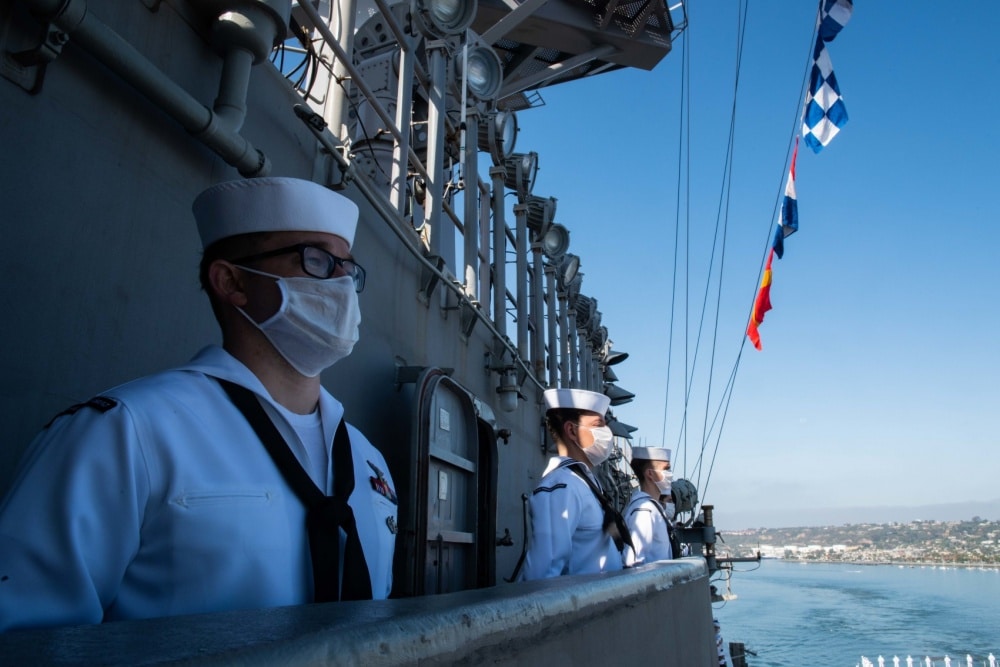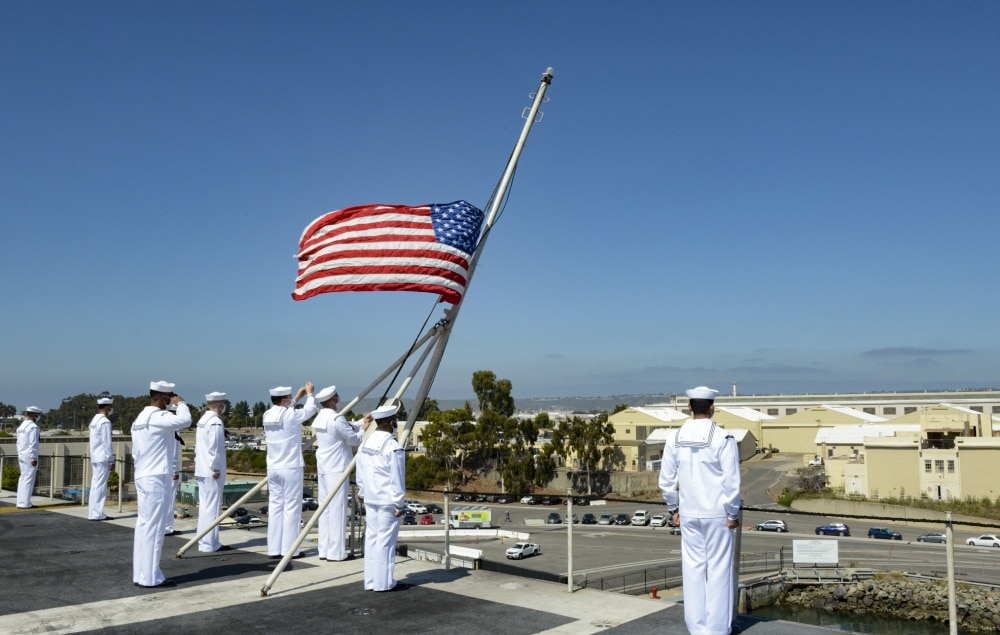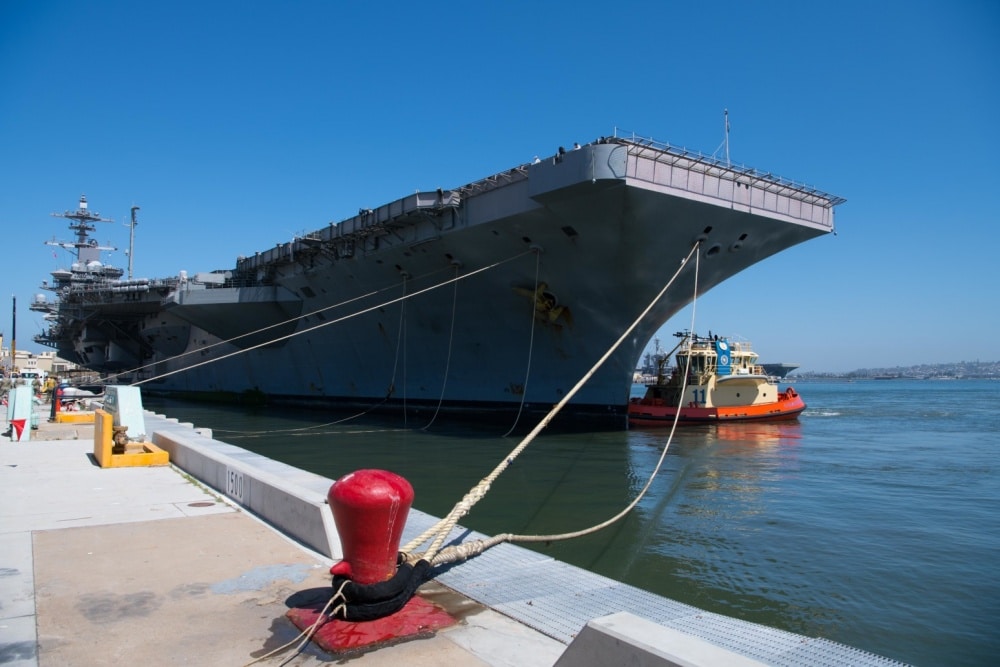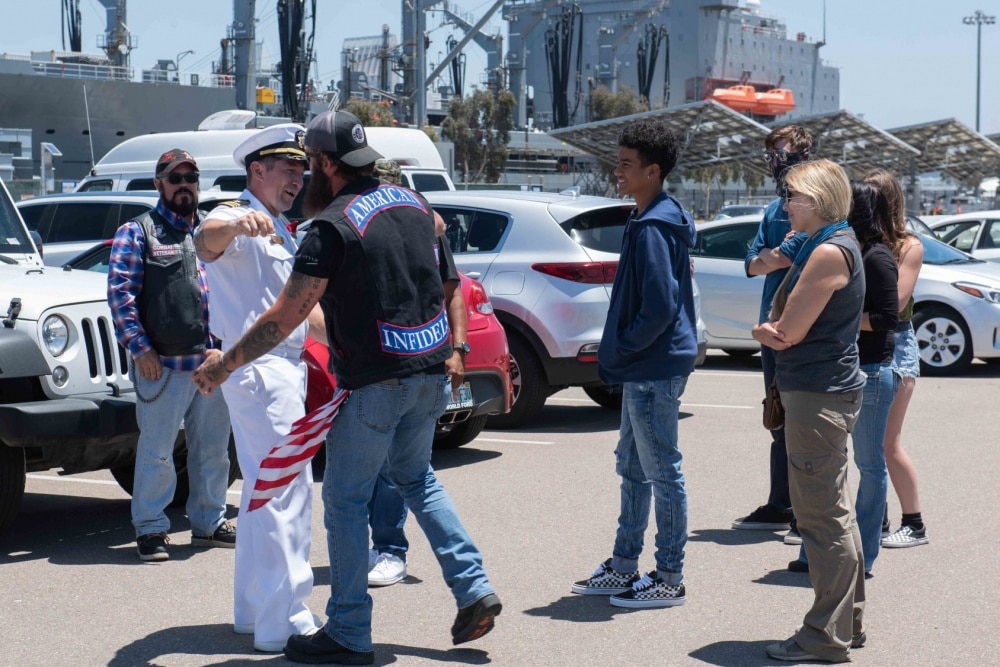USS Theodore Roosevelt, a Navy aircraft carrier on what would have been a routine deployment before the coronavirus sickened more than 1,000 of its sailors, returned from its tumultuous, 31,835-nautical-miles passage to its homeport in San Diego on Thursday, July 9.
On Jan. 17, the carrier left the Naval Air Station North Island with about 4,845 aboard for a deployment with a strike force of six ships to provide maritime security in the Indo-Pacific region.
In early March, the coronavirus pandemic that was spreading around the globe made its way onto the ship, and by mid-April, 1,273 sailors were sick. The aircraft carrier was forced to stop in Guam so the infected crew could be quarantined.

U.S. Sailors man the rails as the aircraft carrier USS Theodore Roosevelt (CVN 71) arrives at Naval Air Station North Island July 9, 2020. Theodore Roosevelt returned to Naval Air Station North Island after a six-month deployment in support of maritime security operations and theater security cooperation efforts in the U.S. 7th Fleet area of operations. (U.S. Navy photo by Mass Communication Specialist Seaman Olympia O. McCoy)
“I am incredibly proud of the Theodore Roosevelt Strike Group and all they’ve accomplished over the deployment,” Rear Adm. Doug Verissimo, commander Carrier Strike Group 9, said. “They operated in a variety of complex environments ranging from how to respond to an international pandemic to operating safely throughout the Indo-Pacific, including the South China Sea.”
In Guam, more than 4,000 members of the crew were moved off the ship to local hotels while about 800 sailors remained aboard to keep watch over its high-tech systems, including nuclear reactors that power it.

U.S. Sailors walk across the flight deck of USS Theodore Roosevelt (CVN 71) after manning the rails as the aircraft carrier arrived at Naval Air Station North Island July 9, 2020. Theodore Roosevelt returned to Naval Air Station North Island after a six-month deployment in support of maritime security operations and theater security cooperation efforts in the U.S. 7th Fleet area of operations. (U.S. Navy photo by Mass Communication Specialist Seaman Olympia O. McCoy)
Two of the sailors died while Roosevelt was at sea. Chief Petty Officer Charles Robert Thacker Jr. on April 13 from COVID-19 complications and, just a few days ago, Navy officials announced Chief Petty Officer Justin Calderone died July 2 after being evacuated from the ship for an unspecified medical emergency.
After requesting the crew be quickly removed from the ship in an email to a few Navy captains and Pacific Fleet admirals, Capt. Brett Crozier, the ship’s commanding officer, was fired on April 2 by then acting-Navy Secretary Thomas Modly. The letter written by Crozier was publicized in the press. Modly flew to Guam and removed Crozier in front of his crew. Modly subsequently resigned from his post on April 7.

U.S. Sailors raise the American flag as the aircraft carrier USS Theodore Roosevelt (CVN 71) arrives at Naval Air Station North Island July 9, 2020. Theodore Roosevelt returned to Naval Air Station North Island after a six-month deployment in support of maritime security operations and theater security cooperation efforts in the U.S. 7th Fleet area of operations. (U.S. Navy photo by Mass Communication Specialist 2nd Class Pyoung K. Yi)
Capt. Carlos Sardiello took over command of the ship in Guam and the Navy launched an internal investigation into how the coronavirus outbreak was handled. Officials announced last month Crozier would not be reinstated.
As sailors began getting healthy and the vessel was sanitized, the crew was slowly moved back on board. On June 4, the ship and its strike group resumed its mission.
Recently, USS Roosevelt and the accompanying group of cruisers, destroyers and airplanes joined two other Navy aircraft carriers strike groups on patrol in the South China Sea – a focal point of U.S. military interests.

Nimitz-class aircraft carrier USS Theodore Roosevelt (CVN 71) is maneuvered into her birth by tug boats. Roosevelt returned to Naval Air Station North Island after a six-month deployment in support of maritime security operations and theater security cooperation efforts in the U.S. 7th Fleet areas of operation. (U.S. Navy photo by Mass Communication Specialist 3rd Class Russell Lindsey)
“The crew of TR persevered displaying uncommon fortitude and tenacity in the face of uncertainty to meet expectations in a crisis,” Sardiello said. “This recovery of the ship and the crew on deployment is a testament to the professionalism of the young men and women of the TR who turned a potentially demoralizing downward spiral into a symbol of inspiration and hope against adversity.”
Unlike usual deployment returns, there were no large groups of cheering families at the dock to receive the ship because of concerns the coronavirus could spread through such a large gathering. Those who came to welcome their sailors watched from their cars.

U.S. Navy Lt. Cmdr. Zachary Macdonald reunites with his family at Naval Air Station North Island July 9, 2020. USS Theodore Roosevelt (CVN 71) returned to Naval Air Station North Island after a six-month deployment in support of maritime security operations and theater security cooperation efforts in the U.S. 7th Fleet area of operations. (U.S. Navy photo by Mass Communication Specialist Seaman Erik Melgar)
In Orange County, Stephanie Oddo, a Laguna Niguel mother who heads up the Healthcare Mask Collaborative, rejoiced hearing the ship and its crew were home.
She had partnered with Robert Harmon, a veteran Navy corpsman from Long Beach, to marshal volunteers to quickly sew masks for the sailors once the outbreak on the ship was reported. They arranged for 5,000 masks to be flown to Guam.

Airman Alex Tate meets his newborn with his wife following Nimitz-class aircraft carrier USS Theodore Roosevelt’s (CVN 71) return from deployment. Roosevelt returned to Naval Air Station North Island after a six-month deployment in support of maritime security operations and theater security cooperation efforts in the U.S. 7th Fleet areas of operation. (U.S. Navy photo by Mass Communication Specialist 3rd Class Russell Lindsey)
“It feels like a big relief,” Oddo said upon hearing of the ship’s return. “We would have been there with bells on if we could.”
“I found it very affirming that the Centers for Disease Control study aboard the Roosevelt found masks were effective in reducing the cases of COVID,” she said. “They have a whole new fan club called Healthcare Mask Collaborative that carries them in their thoughts and prayers.”
Two of the ships in Roosevelt’s strike group, USS Bunker Hill and USS Russell, returned from their deployments on Wednesday, July 8.
___
© 2020 The Orange County Register
Distributed by Tribune Content Agency, LLC.



